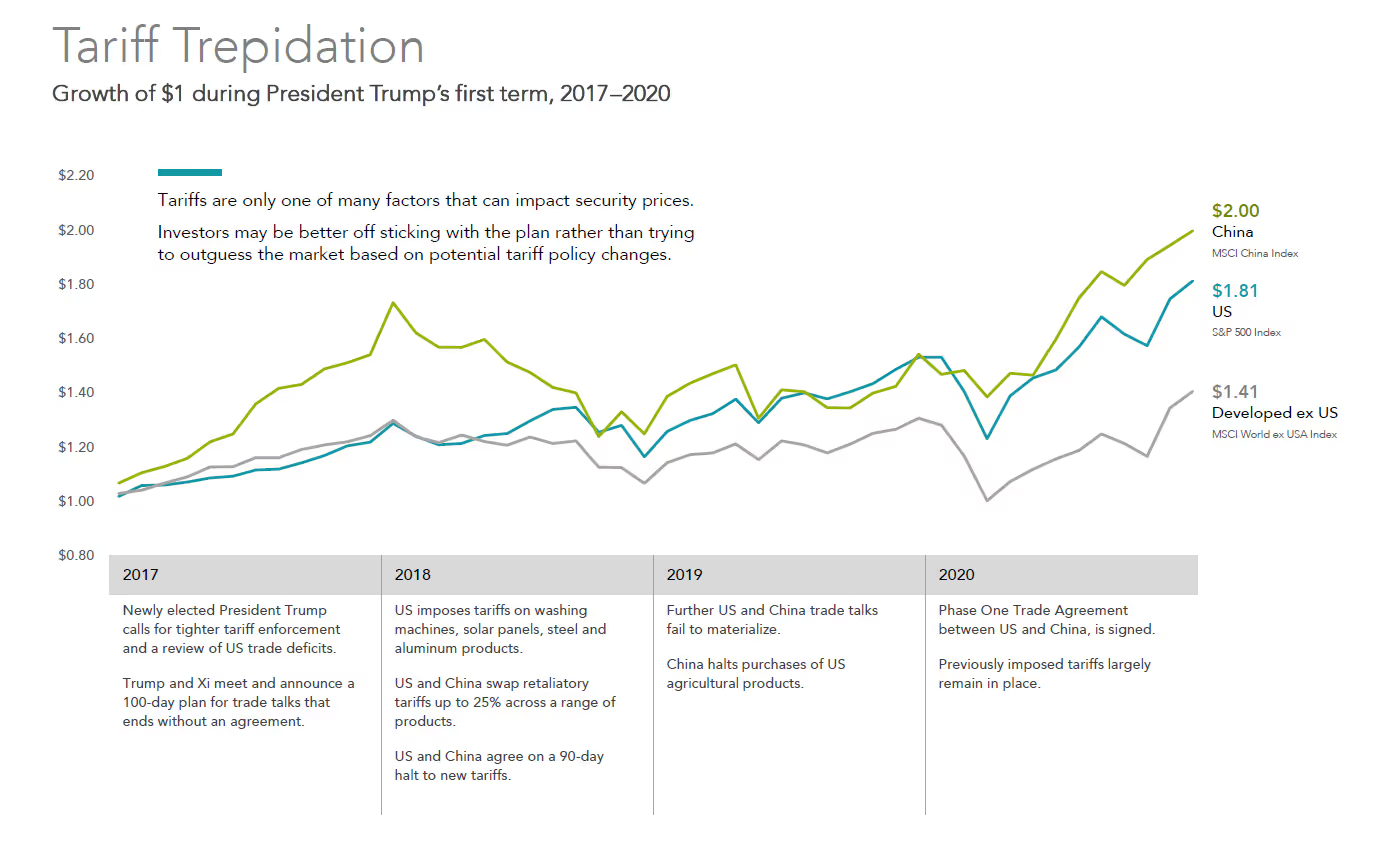2025 Tariffs: What They Could Mean for Your Wallet, Shopping, and Investments
Key takeaways
Prices may rise
Everyday essentials like groceries, gas, and electronics may see price hikes due to new tariffs on imports from China, Canada, and Mexico. As of February 3, 2025, however, both Mexico and Canada have reached an agreement with President Trump to pause tariffs for 30 days.
Stock market ups and downs
Markets may react sharply in the short term, but long-term investors should stay focused on their financial goals.
Stay focused, not reactionary
A well-diversified portfolio helps minimize volatility, and making knee-jerk investment decisions could do more harm than good.
What’s happening?
Imagine going grocery shopping and realizing your favorite avocado toast is suddenly a luxury. Or heading to the gas station and noticing the price per gallon creeping higher. That’s the reality many Americans could face with the newly introduced 2025 tariffs.
The U.S. government has imposed tariffs ranging from 10% to 25% on goods from China, Mexico, and Canada. These added costs may trickle down to consumers in the form of higher prices on everyday goods.
How will this affect you?
Groceries and drinks
Costs may rise for imported staples like avocados, tomatoes, and beer.
Electronics and clothing
Higher costs on Chinese imports could make smartphones, laptops, and apparel more expensive.
Fuel prices
A tariff on Canadian crude oil could push gas prices up by about 10 cents per gallon.
Impact on investments
If you’ve been checking your investment portfolio lately, you might have noticed some volatility. The stock market often reacts quickly to economic shifts like tariffs, with investors worried about supply chain disruptions and inflation. Market volatility is normal and expected.
Staying the course is key. Instead of making reactionary decisions based on short-term market noise, focus on long-term financial goals. Proper diversification is essential. Owning a mix of stocks, bonds, and other assets helps minimize the impact of any single economic event.
History has shown that while markets may dip in response to trade tensions, they also recover. If you panic and sell when prices drop, you risk missing out on the eventual rebound. Instead of stressing over daily fluctuations, consider this a time to reassess your financial plan and ensure your investments align with your risk tolerance.
One period offering perspective on this issue is President Trump’s first term in office. Beginning in 2017, the administration eyed China as a target and, by 2018, began imposing tariffs across a range of products. The next couple of years saw back and forth trade discussions that eventually led to an agreement, though pre-existing tariffs remained in place. Despite all this uncertainty, both China and the US posted higher cumulative returns than the MSCI World ex USA Index over the four years of Trump’s term.

Source: Dimensional Past performance is not a guarantee of future results. In USD. Data shown from January 1, 2017, to December 31, 2020. Growth of wealth shows the growth of a hypothetical investment of $1. Data presented in the growth of wealth chart is hypothetical and assumes reinvestment of income and no transaction costs or taxes. The chart is for illustrative purposes only and is not indicative of any investment. Performance includes reinvestment of dividends and capital gains. MSCI China Index and MSCI World ex USA Index returns are net dividend. Tarif events data sourced from Reuters. S&P data © 2025 S&P Dow Jones Indices LLC, a division of S&P Global. All rights reserved. MSCI data © MSCI 2025, all rights reserved. Indices are not available for direct investment; therefore, their performance does not reflect the expenses associated with the management of an actual portfolio.
The bottom line
While tariffs can lead to higher prices and temporary market jitters, they don’t have to derail your financial future. Being an informed consumer and investor means understanding the bigger picture. Prices may rise, and stocks may see volatility, but smart financial strategies, like budgeting wisely and maintaining a well-diversified portfolio will help you navigate these changes with confidence.
Key takeaways
Prices may rise
Everyday essentials like groceries, gas, and electronics may see price hikes due to new tariffs on imports from China, Canada, and Mexico. As of February 3, 2025, however, both Mexico and Canada have reached an agreement with President Trump to pause tariffs for 30 days.
Stock market ups and downs
Markets may react sharply in the short term, but long-term investors should stay focused on their financial goals.
Stay focused, not reactionary
A well-diversified portfolio helps minimize volatility, and making knee-jerk investment decisions could do more harm than good.
What’s happening?
Imagine going grocery shopping and realizing your favorite avocado toast is suddenly a luxury. Or heading to the gas station and noticing the price per gallon creeping higher. That’s the reality many Americans could face with the newly introduced 2025 tariffs.
The U.S. government has imposed tariffs ranging from 10% to 25% on goods from China, Mexico, and Canada. These added costs may trickle down to consumers in the form of higher prices on everyday goods.
How will this affect you?
Groceries and drinks
Costs may rise for imported staples like avocados, tomatoes, and beer.
Electronics and clothing
Higher costs on Chinese imports could make smartphones, laptops, and apparel more expensive.
Fuel prices
A tariff on Canadian crude oil could push gas prices up by about 10 cents per gallon.
Impact on investments
If you’ve been checking your investment portfolio lately, you might have noticed some volatility. The stock market often reacts quickly to economic shifts like tariffs, with investors worried about supply chain disruptions and inflation. Market volatility is normal and expected.
Staying the course is key. Instead of making reactionary decisions based on short-term market noise, focus on long-term financial goals. Proper diversification is essential. Owning a mix of stocks, bonds, and other assets helps minimize the impact of any single economic event.
History has shown that while markets may dip in response to trade tensions, they also recover. If you panic and sell when prices drop, you risk missing out on the eventual rebound. Instead of stressing over daily fluctuations, consider this a time to reassess your financial plan and ensure your investments align with your risk tolerance.
One period offering perspective on this issue is President Trump’s first term in office. Beginning in 2017, the administration eyed China as a target and, by 2018, began imposing tariffs across a range of products. The next couple of years saw back and forth trade discussions that eventually led to an agreement, though pre-existing tariffs remained in place. Despite all this uncertainty, both China and the US posted higher cumulative returns than the MSCI World ex USA Index over the four years of Trump’s term.

Source: Dimensional Past performance is not a guarantee of future results. In USD. Data shown from January 1, 2017, to December 31, 2020. Growth of wealth shows the growth of a hypothetical investment of $1. Data presented in the growth of wealth chart is hypothetical and assumes reinvestment of income and no transaction costs or taxes. The chart is for illustrative purposes only and is not indicative of any investment. Performance includes reinvestment of dividends and capital gains. MSCI China Index and MSCI World ex USA Index returns are net dividend. Tarif events data sourced from Reuters. S&P data © 2025 S&P Dow Jones Indices LLC, a division of S&P Global. All rights reserved. MSCI data © MSCI 2025, all rights reserved. Indices are not available for direct investment; therefore, their performance does not reflect the expenses associated with the management of an actual portfolio.
The bottom line
While tariffs can lead to higher prices and temporary market jitters, they don’t have to derail your financial future. Being an informed consumer and investor means understanding the bigger picture. Prices may rise, and stocks may see volatility, but smart financial strategies, like budgeting wisely and maintaining a well-diversified portfolio will help you navigate these changes with confidence.








.avif)



